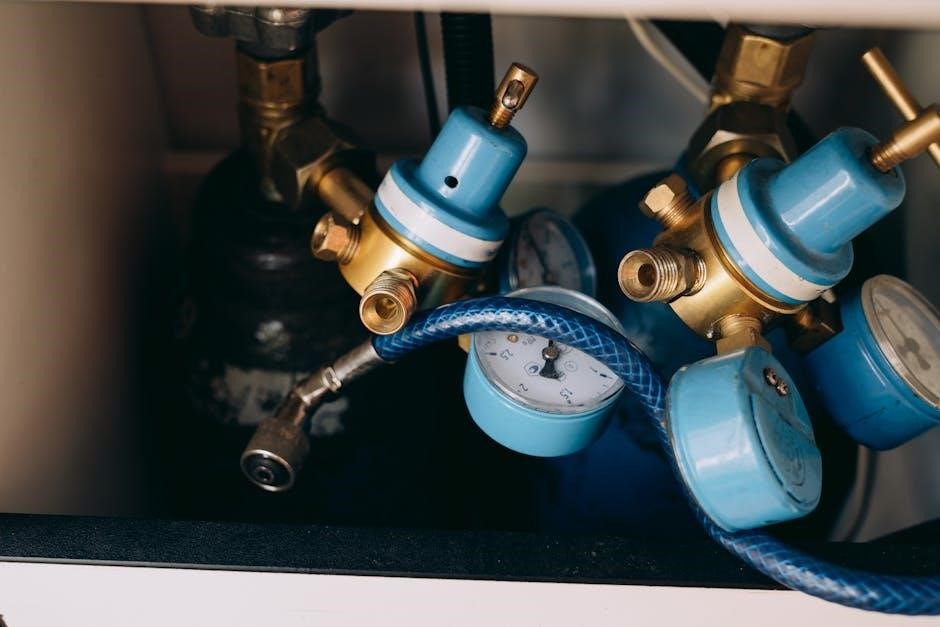Valve guide honing is a precision machining process that refinishes valve guide bores to improve engine efficiency and performance. It ensures proper valve alignment, reduces wear, and extends engine life.
1.1 What is Valve Guide Honing?
Valve guide honing is a precision machining process used to refine the inner surfaces of valve guides in engines. It involves using specialized tools, such as honing stones, to create a smooth, round, and straight surface. This process ensures proper valve alignment, improves sealing, and reduces wear. Honing is often necessary after valve guides become worn or misaligned, restoring them to optimal condition. It is a critical step in engine maintenance and rebuilding, ensuring efficient engine performance and longevity.
1.2 Importance of Valve Guide Honing in Engine Maintenance
Valve guide honing is essential for maintaining engine health and performance. It ensures proper valve alignment, reducing wear on engine components and preventing leaks. Honing restores damaged or worn valve guides, improving sealing and reducing oil consumption. This process also enhances fuel efficiency and overall engine longevity. Regular honing is critical for preventing premature engine failure and maintaining optimal performance, making it a vital step in engine maintenance and rebuilding. It addresses common issues like misalignment and wear, ensuring smoother engine operation.

Understanding Valve Guides
Valve guides are critical engine components that ensure proper valve alignment and sealing, directly impacting engine performance and longevity.
2.1 What are Valve Guides?
Valve guides are cylindrical components located in an engine’s cylinder head, designed to guide the valve stem and maintain proper alignment. They ensure the valve moves smoothly and seals correctly, preventing oil leakage and maintaining compression. Typically made from durable materials like bronze or steel, valve guides play a crucial role in engine efficiency and performance. Over time, they can wear out, leading to issues like increased oil consumption and reduced engine power, making maintenance or replacement necessary to restore optimal engine function.
2.2 Purpose and Function of Valve Guides in Engines
The primary purpose of valve guides is to ensure precise movement and alignment of engine valves, maintaining proper sealing and preventing oil leakage. They guide the valve stem during operation, reducing wear and tear on engine components. By keeping the valve accurately positioned, they help maintain compression, optimize combustion efficiency, and reduce emissions. Properly functioning valve guides are essential for smooth engine operation, performance, and longevity, making them a critical component in overall engine health and reliability.
2.3 Common Materials Used for Valve Guides
Valve guides are typically made from durable materials like cast iron, steel alloys, or bronze. These materials are chosen for their strength, heat resistance, and ability to withstand engine wear. Cast iron is commonly used due to its excellent thermal properties and cost-effectiveness. Steel alloys offer superior strength and durability, while bronze provides excellent wear resistance and lubricity. The choice of material depends on the engine’s specific requirements, ensuring optimal performance, longevity, and compatibility with honing processes to maintain precise valve alignment and engine efficiency.

Tools and Equipment for Valve Guide Honing
Specialized tools like honing machines, Flex-Hone brushes, and stone sets are used to precision-refinish valve guides, ensuring proper valve alignment and engine performance.
3.1 Overview of Honing Tools
Honing tools are essential for maintaining and repairing valve guides, ensuring precise surface finishing. They include hand-held honing stones, mechanical honing machines, and CNC-compatible tools. These devices feature adjustable stones and precision guides to achieve accurate bore sizes. Designed for various engine materials, they restore proper valve alignment and prevent leakage. Popular brands offer high-quality honing tools tailored for different engine types, ensuring optimal performance and durability. Regular use of these tools extends engine life and improves overall efficiency.
3.2 Types of Honing Tools
Honing tools vary to suit different engine needs. Hand honing stones are simple, cost-effective options for minor repairs. Mechanical honing machines offer precision and speed for larger-scale work. CNC-compatible tools integrate with advanced machinery for high-precision tasks. Flex-Hone tools are ideal for finishing and deburring. Each type ensures accurate valve guide restoration, improving engine performance and longevity. Proper tool selection depends on the engine’s material and the extent of guide wear, making them indispensable in engine maintenance and rebuilding processes.
3.3 Features of High-Quality Honing Tools
High-quality honing tools are designed for precision and durability. They feature adjustable handles for better control and diamond-coated stones for consistent finishes. Many tools are compatible with various materials, including cast iron and stainless steel. Advanced models include self-centering capabilities to ensure straight, round holes. Durable construction and easy-to-replace stones extend tool life. These features ensure accurate valve guide restoration, leading to improved engine performance and longevity. Investing in high-quality tools is essential for professional-grade results in engine maintenance and rebuilding.
3.4 Specialized Honing Machines
Specialized honing machines are designed for precise valve guide finishing. They feature advanced automation and high-precision controls to ensure consistent results. These machines often include adjustable speed settings and coolant systems to prevent overheating. Models like the Robins Guide Honing Machine are known for their accuracy and durability. They are capable of handling various materials, including cast iron and stainless steel. Such machines are essential for professional engine rebuilders, offering superior finish quality and efficiency compared to manual tools.
The Honing Process
The honing process involves using specialized tools to refine valve guide surfaces for optimal precision and performance. It ensures proper valve alignment and reduces engine wear.
4.1 Step-by-Step Guide to Honing Valve Guides
The process begins with preparing the engine by removing valves and ensuring guides are accessible. Next, select the appropriate honing tool and attach it to a drill or machine. Apply a small amount of honing oil to the tool and guide surface. Start with a slow, steady motion, moving the tool up and down the guide bore. Gradually increase speed while maintaining consistent pressure. After achieving the desired surface finish, clean the area thoroughly to remove any debris. Finally, inspect the guide for accuracy and roundness.
4.2 Preparing the Engine for Honing
Before honing, remove the valves and valve springs to access the guides. Clean the area thoroughly to eliminate dirt and debris. Inspect the guides for damage or excessive wear. If necessary, use a pilot tool to center the hone within the guide bore. Ensure the cylinder head is securely fastened to prevent movement during the process. Apply a light coat of honing oil to the guide surface to facilitate smooth operation. Proper preparation ensures accurate results and prevents potential damage to the engine or tools.
4.3 Safety Precautions During the Honing Process
Wear protective gear, including safety glasses, gloves, and a dust mask, to prevent injury from debris. Ensure proper ventilation to avoid inhaling metal particles or oil mist. Secure the engine and tools firmly to prevent accidental movement. Keep loose clothing and long hair tied back to avoid entanglement with machinery. Use honing oil correctly to prevent overheating and maintain control of the tool. Avoid over-revving the hone, as it can cause damage or loss of control. Always follow manufacturer guidelines for tool operation and safety protocols.
Benefits of Valve Guide Honing
Valve guide honing enhances engine performance, improves fuel efficiency, extends engine life, and reduces maintenance costs. It ensures proper valve alignment, minimizing wear and tear for optimal durability.
Valve guide honing significantly enhances engine performance by ensuring precise valve alignment and smooth operation. This process reduces friction and wear, allowing valves to open and close efficiently. Improved sealing and airflow contribute to better combustion, increasing power output and responsiveness. Additionally, honing minimizes engine noise and vibration, providing a smoother driving experience. Overall, this procedure is essential for maintaining peak engine performance and reliability, making it a critical step in engine maintenance and rebuilding processes. Valve guide honing contributes to increased fuel efficiency by optimizing engine performance. Improved sealing and reduced valve leakage ensure better combustion efficiency, minimizing fuel waste. Enhanced airflow and precise valve operation reduce energy loss, allowing the engine to run more efficiently. This process also lowers emissions and operational strain, further improving fuel economy. By maintaining proper valve guide alignment, honing helps the engine achieve its maximum potential, translating to better mileage and reduced fuel consumption over time. This makes it a valuable procedure for both performance and environmental benefits. Valve guide honing plays a crucial role in extending engine life by reducing wear on critical components. Properly honed valve guides ensure precise valve alignment, minimizing lateral movement that can cause premature wear. This process also improves sealing, reducing the risk of oil leakage and contamination. By maintaining optimal valve guide condition, honing prevents excessive heat generation and stress on engine parts, which are common causes of early engine failure. Regular honing helps maintain engine health, ensuring longevity and reliable performance over time. Valve guide honing is a cost-effective solution for engine maintenance, offering significant savings compared to replacing damaged components. By restoring valve guides to optimal condition, honing eliminates the need for expensive replacements and reduces labor costs. This process extends the life of engine parts, delaying the need for major overhauls. Additionally, honing prevents premature wear that could lead to costly repairs down the line. It is a budget-friendly option for maintaining engine performance and reliability, making it a practical choice for both professional mechanics and DIY enthusiasts. Honing addresses worn or damaged valve guides, misalignment, and sealing issues, ensuring proper valve function and engine performance. It restores surface finish and prevents further damage. Worn or damaged valve guides can lead to poor engine performance, increased oil consumption, and reduced efficiency. Honing restores the surface finish of the guide bores, ensuring proper valve alignment and sealing. This process removes minor damage, such as scoring or wear, and creates a smooth surface for the valve stem to operate within. By addressing worn guides, honing prevents further damage to engine components and maintains optimal combustion chamber integrity. Tools like the Two Stone Valve Guide Hone Set are commonly used for this purpose, ensuring precise and effective results. Misaligned valves can cause poor engine performance, improper sealing, and increased wear on valve train components. Honing helps correct alignment issues by refining the valve guide bores, ensuring proper stem-to-guide clearance. This process minimizes lateral movement of the valve, improving sealing and reducing wear. Tools like the Two Stone Valve Guide Hone Set are effective in addressing misalignment by creating precise, round bores. Proper alignment ensures efficient combustion and reduces the risk of engine damage, making honing a critical step in maintaining optimal valve function. Leaks and sealing issues often arise from worn or damaged valve guides, leading to poor engine performance and increased emissions. Honing restores the surface finish of valve guide bores, ensuring proper sealing between the valve stem and guide. This process eliminates excessive clearance, which can cause leaks and reduce engine efficiency. Tools like the Two Stone Valve Guide Hone Set and Brush Research BC8M18 FLEX-HONE are designed to create smooth, precise surfaces, improving seal integrity and preventing fluid leakage. Regular honing helps maintain optimal engine sealing performance. Selecting the right honing tool ensures precise valve guide refinishing. Consider factors like compatibility, precision, and ease of use. Tools like the Kibblewhite Valve Guide Ball Hone and Brush Research BC8M18 FLEX-HONE are ideal for achieving smooth, accurate surfaces. When selecting a honing tool for valve guides, consider the tool’s compatibility with your engine’s specifications, such as bore size and material. Precision and accuracy are crucial to ensure proper valve alignment and prevent wear. Ease of use and durability should also be evaluated to maintain efficiency during the honing process. Additionally, the tool’s ability to achieve a smooth finish and maintain roundness is essential for optimal engine performance. Always choose tools from reputable brands known for quality and reliability. Prominent brands like Kibblewhite and Brush Research offer high-quality honing tools. Kibblewhite’s valve guide ball hone is known for its precision and durability, suitable for various engine types. Brush Research’s Flex-Hone tool is renowned for its flexibility and ability to achieve smooth finishes on valve guides. These brands emphasize accuracy, ease of use, and compatibility with different materials, ensuring optimal results in engine maintenance and rebuilding. Their tools are widely trusted in both professional and DIY engine repair scenarios. Customers and professionals highly recommend tools from brands like Kibblewhite and Brush Research for valve guide honing. Kibblewhite’s ball hone is praised for its ease of use and precision, while Brush Research’s Flex-Hone is lauded for its versatility. Users highlight their durability and effectiveness in achieving smooth finishes. These tools are cost-effective and widely preferred for both professional and DIY engine repairs. Experts often recommend them for consistent results and reliability, making them top choices in the market for valve guide honing applications. Regular cleaning and proper storage of honing tools are essential to maintain their precision. Sharpening or replacing honing stones ensures optimal performance and extends tool life. Proper cleaning and storage of honing tools are crucial for maintaining their effectiveness. After use, tools should be thoroughly cleaned with a solvent to remove metal particles and debris. Drying is essential to prevent rust. Store tools in a dry, protected area, ideally in their original packaging or a designated case. Regularly inspect tools for damage or wear. Following these steps ensures tools remain in optimal condition, ready for future use and extending their service life. Sharpening and replacing honing stones is essential for maintaining tool effectiveness. Use a diamond dresser to sharpen stones, ensuring proper angles and surface renewal. Replace stones when they show excessive wear or no longer produce the desired finish. Regular inspection helps determine when replacement is needed. Always use high-quality stones designed for your specific tool to ensure precision and durability. Proper maintenance extends tool life and guarantees consistent results in valve guide honing processes. Regular inspection of honing tools is crucial for maintaining performance and extending their lifespan. Check for wear on stones, alignment issues, and damage to the tool’s mechanical components. Inspect the honing stones for dullness or uneven wear, as this can affect the finish quality. Clean the tool thoroughly after each use to prevent debris buildup. Schedule inspections based on usage frequency to ensure optimal condition. Neglecting regular checks can lead to poor honing results and potential engine damage. Consistent maintenance ensures precision and reliability in valve guide honing processes. Common issues include uneven honing, excessive wear, and tool malfunction. These problems often arise from improper tool alignment, worn stones, or insufficient lubrication during the process. Uneven honing occurs when the valve guide surface isn’t uniformly smoothed, often due to improper tool alignment or uneven pressure. This can lead to poor valve seating and reduced engine performance. To address this, ensure the honing tool is correctly aligned and evenly applied. Regularly inspect and replace worn honing stones, as they can cause inconsistent finishes. Proper lubrication and maintaining consistent strokes during the process also help achieve a smooth, even surface. Addressing these factors ensures optimal results and prevents further engine issues. Excessive wear during valve guide honing can occur due to improper tool usage, insufficient lubrication, or using low-quality honing stones. This leads to over-removal of material, potentially damaging the valve guide. To prevent this, use high-quality tools designed for the specific material and ensure proper lubrication. Regularly inspect the honing stones for wear and replace them as needed. Maintaining consistent pressure and stroke rates during the process also helps minimize wear. Addressing these factors ensures the valve guides remain within specified tolerances and maintains engine performance. Tool malfunction during valve guide honing can lead to inconsistent surface finishes or damage to the valve guides. Common causes include improper tool setup, worn or damaged honing stones, or insufficient lubrication. Malfunctioning tools may vibrate excessively, causing uneven wear or scratches on the guide bore. To address this, ensure tools are properly calibrated and maintained; Regularly inspect honing stones for wear and replace them as needed. Using high-quality tools and following manufacturer guidelines can prevent malfunctions and ensure precise, reliable results during the honing process. Case studies highlight valve guide honing’s role in engine rebuilding, improving performance and longevity. Tools like two-stone hones and Kibblewhite’s ball hone are widely used in automotive and aerospace industries. Engine rebuilders have achieved remarkable results using valve guide honing tools. A Honda XR250R rebuild successfully restored cylinder head performance with precise honing. Similarly, automotive shops report extended engine life and reduced oil consumption after honing. These success stories underscore the effectiveness of honing in maintaining engine health and performance. Tools like two-stone hones and specialized machines have become essential in achieving these outcomes. Valve guide honing is widely applied across various industries, including automotive, aerospace, and hydraulics. In automotive, it’s crucial for engine rebuilding, while in aerospace, it ensures precise valve alignment in jet engines. Hydraulic systems rely on honing for maintaining fluid control accuracy. The process is also used in industrial machinery to extend equipment life. Each industry benefits from improved performance, reduced wear, and enhanced reliability, making honing a versatile and essential technique across sectors. Its adaptability underscores its importance in modern manufacturing and maintenance. DIY valve guide honing can be cost-effective for enthusiasts with proper tools and expertise, but it carries risks like improper alignment or damage. Professional honing, while more expensive, ensures precision and reliability, often using specialized equipment. DIY suits small-scale projects, while professionals handle complex engine rebuilds. The choice depends on skill level, resources, and desired outcomes. For critical applications, professional services are recommended to avoid costly mistakes and ensure optimal results. Balancing cost and quality is key in deciding the approach. Future trends include integrating advanced technologies like AI and IoT for precision, adopting eco-friendly practices, and automating honing processes to enhance efficiency and reduce human error. Recent advancements in tool technology have introduced high-precision honing systems with adjustable stones and automated feed controls. These tools minimize human error and improve surface finish. Additionally, the development of diamond-coated honing stones has enhanced durability and cutting efficiency. Modern machines now incorporate CNC capabilities, allowing for precise, repeatable results. Such innovations are expected to further streamline the honing process, reducing time and increasing accuracy in engine rebuilding and maintenance applications. These tools are becoming indispensable in both professional and DIY settings. Environmental considerations in valve guide honing focus on minimizing waste and reducing emissions. Modern honing tools are designed to produce minimal metal shavings, reducing environmental impact. Eco-friendly cutting fluids and recyclable materials are increasingly used. Additionally, energy-efficient honing machines lower power consumption, contributing to sustainability. These practices align with global efforts to reduce industrial pollution and promote greener manufacturing processes. By adopting environmentally responsible techniques, the honing process becomes more sustainable while maintaining high performance standards. This approach is crucial for meeting future environmental regulations and industry expectations. Automation in valve guide honing is revolutionizing the industry by enhancing precision and efficiency. Computer-controlled machines now perform honing with minimal human intervention, ensuring consistent results. Robotic systems equipped with advanced sensors optimize the process, reducing errors and improving surface finish. Automated honing also enables real-time monitoring and adjustments, ensuring adherence to tight tolerances. This technology not only accelerates production but also reduces labor costs, making it a key advancement in modern engine maintenance. Automation is set to become a standard in honing processes, driving innovation and scalability. Valve guide honing is essential for maintaining engine performance, efficiency, and longevity. Proper tools and techniques ensure precise results, making it a critical step in engine maintenance. Valve guide honing is a critical process in engine maintenance that ensures proper valve alignment, reduces wear, and enhances performance. It involves using specialized tools like honing stones and machines to refinish valve guide bores. Regular honing extends engine life, improves fuel efficiency, and prevents costly repairs. Proper techniques and high-quality tools are essential for achieving precise results. This process is widely used in various industries, including automotive and industrial applications, making it a vital skill for mechanics and engineers. Valve guide honing is indispensable for maintaining optimal engine performance and longevity. By ensuring precise valve alignment and minimizing wear, it prevents premature engine failure and reduces operational costs. Regular honing contributes to smoother engine operation, better fuel efficiency, and reduced emissions. As engines evolve, the role of honing remains crucial, emphasizing the need for skilled technicians and quality tools. Investing in proper honing techniques is essential for both professional mechanics and DIY enthusiasts to achieve lasting engine health and reliability.5.1 Improved Engine Performance
5.2 Increased Fuel Efficiency
5.3 Extended Engine Life
5.4 Cost-Effectiveness
Common Issues Addressed by Honing
6.1 Worn or Damaged Valve Guides
6.2 Misaligned Valves
6.3 Leaks and Sealing Problems

Choosing the Right Honing Tool
7.1 Factors to Consider
7.2 Popular Brands and Their Features
7.3 Reviews and Recommendations
Maintenance and Care of Honing Tools
8.1 Cleaning and Storage
8.2 Sharpening and Replacing Honing Stones
8.3 Regular Inspection

Troubleshooting Common Honing Issues
9.1 Uneven Honing
9.2 Excessive Wear
9.3 Tool Malfunction

Case Studies and Real-World Applications

10.1 Success Stories in Engine Rebuilding
10.2 Honing in Different Industries
10.3 DIY vs. Professional Honing
Future Trends in Valve Guide Honing
11.1 Advances in Tool Technology

11.2 Environmental Considerations
11.3 Automation in Honing Processes

12.1 Summary of Key Points

12.2 Final Thoughts on the Importance of Valve Guide Honing
